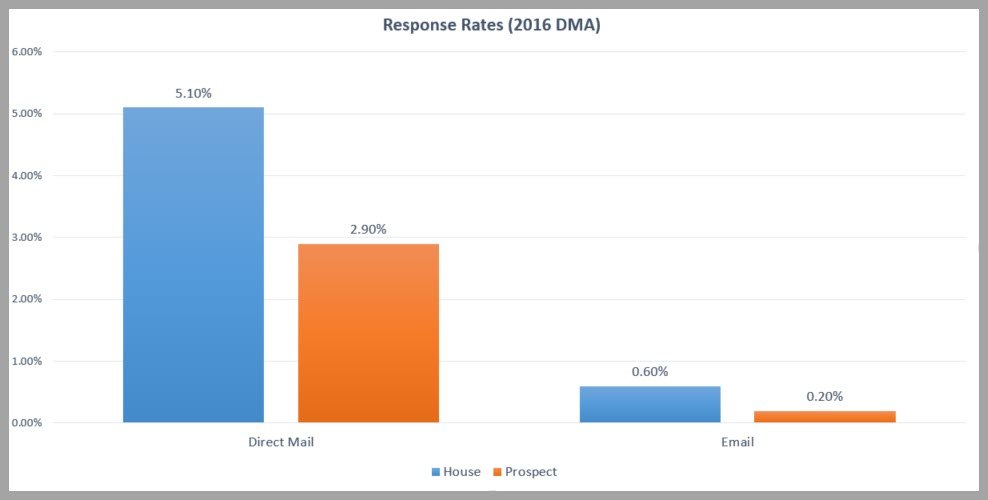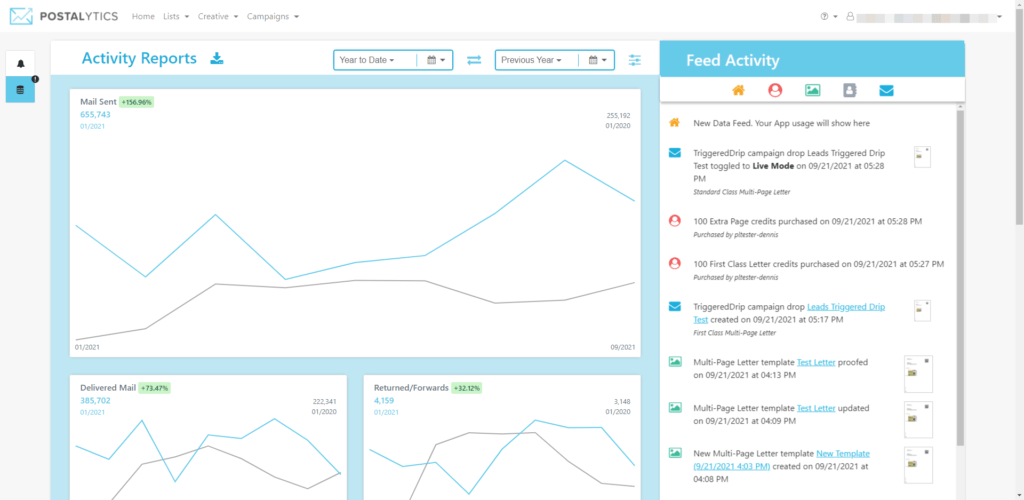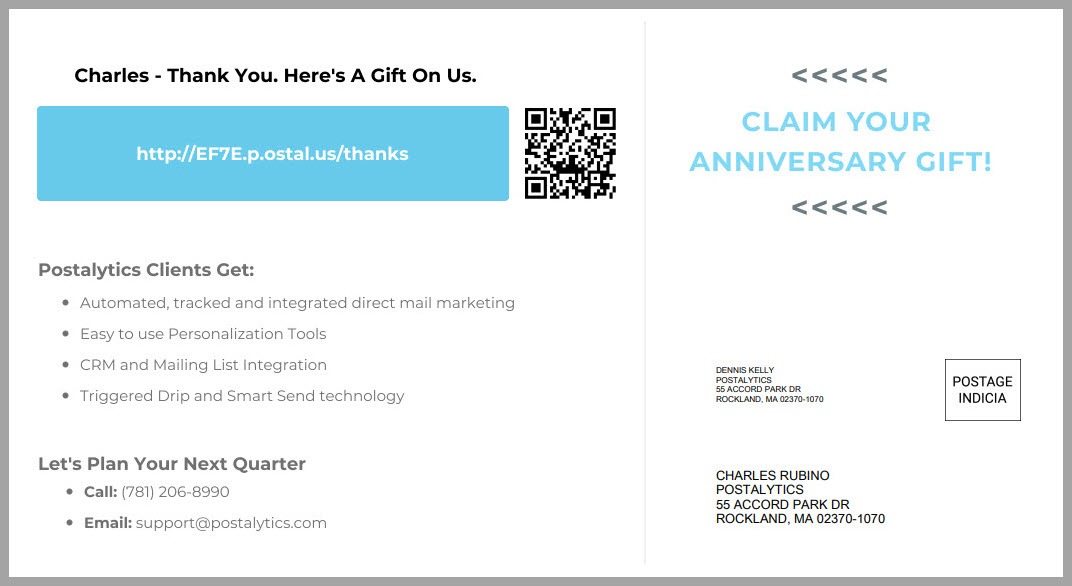“What kind of direct mail ROI can I expect?”
That’s the question that we see here most at Postalytics among companies that want to get started with direct mail advertising. As a channel, direct mail has a perception among marketers raised on digital that it is less effective and more of a hassle than digital channels. With modern tools, that couldn’t be farther from the truth.
Direct mail is among the oldest and most effective advertising channels. It has been tried and tested in every industry, category, and niche. Although sometimes viewed as outdated in favor of digital channels, direct mail actually provides one of the highest, most reliable ROIs of any advertising channel. If used correctly, it can be a game changer for companies looking to expand their advertising operations.

The ROI of Direct Mail
Direct mail is still one of the most popular advertising channels in use today and for good reason — it provides reliable returns that often surpass digital channels. While everyone joins the fight to modernize and build a presence on the web, companies that embrace new technology that enhances traditional advertising channels often find them less competitive and more reliable.
To understand what direct mail ROI you can realistically expect, you first have to understand the costs of running a direct mail campaign. In a recent article, we covered this topic in depth. Ultimately, your cost depends heavily on what tasks you can complete in-house and what you have to pay to have done. A company with in-house designers and copywriters will almost always pay less than one that has to outsource that work. When you use direct mail automation tools to streamline the production and fulfillment processes, you’ll cut the time and cost side of the equation dramatically.
Get A Free Postalytics Account
According to recent research, direct mail has a response rate of 5.1%. That might not sound like much, but when you compare it to 0.2% from online ads, 0.4% from social media platforms, 0.6% from paid search, and 0.6% from email campaigns, you can start to understand how significant that number is.

Direct Mail Response Rate Is Growing With Better Tech
It used to be that marketers would expect about a 1% response rate on direct mail. Now, with better direct mail software, data and printing technology, the response rate is growing. As digital channels have grown more crowded, direct mail is connecting at a higher frequency. Why? Because it is a better product! Beautiful images on oversized postcard highly personalized letters that use data targeting to increase their appeal are making a big difference in response. Combined with new automated campaigns that strip out much of the time associated with preparing direct mail, the ROI is rapidly increasing.
According to a recent study from DMA, the median Direct mail ROI is 29%. Only seriously outpaced by email (124%), that return places direct mail as better than or virtually equal to popular digital channels like social media (30%), paid search (24%), and online display (16%). On the higher end of the return scale, a 2013 study found that for every $167 that businesses spend on direct mail, they sell $2095 worth of products and services.
It isn’t all about the return, either. Direct mail advertisements have a better reputation among modern consumers. They prefer direct mail. In fact, 73% of consumers claim to prefer direct mail over other channels for brand communications. Also, 40% of consumers claim they will try new services and products if they receive direct mail from the business that offers them.
How to Maximize Direct Mail ROI
Direct mail is what you make it. Like any other channel, the initial ROI of your first campaign is usually a poor indicator of the channel’s overall potential. You’ll need to track, measure, and optimize your campaigns to improve their returns over time. As you learn what your audiences respond to, you’ll find more reliable returns through the channel.
Touch, Test, Touch Again
What would you think of a sales rep that calls a prospect once, leaves a message, and never calls again? You’d probably fire him or her. That’s the equivalent of first time direct mailers that send out a single campaign and expect huge sales to happen. Good sales people know they need to touch their prospects several times, with clear goals for each touch. The same applies with direct mail.
Frequency is an important advertising concept. We see very successful clients that send to the same list, with variations in format (postcard sizes & letters) and creative, between 3-7 times. Postalytics makes this easy, enabling you to send to only the non-responders with our unique “Add A Maildrop” feature. Send to your list, makes some changes in the copy, the offer and the call to action, and send again. Learn from each of your sends.

You Can Only Act On What You Track
Just as with every marketing campaign, you have to track your metrics. What percentage of your total sent pieces reached their destination? How many were returned? Who opened and engaged with your mailer? Knowing where the flaws were in a campaign puts you in a position to improve.
In the past, tracking direct mail campaigns was very difficult. However, Postalytics has changed that. By connecting directly with the most popular marketing and analytics platforms available today, we make it easy to understand the effectiveness of your direct mail campaigns and accurately track direct mail ROI.
Our system integrates with platforms like:
- HubSpot
- SalesForce
- Zapier
- ActiveCampaign
- InfusionSoft
- Marketo
- Drip
- Zoho
That’s just a small sampling of the total number of platforms and tools that Postalytics integrates with. To maximize your direct mail ROI, you have to track your campaigns. Our solutions allow you to do that with fewer headaches and lower campaign costs.
Our system provides companies with the tools that they need to effectively track and optimize their direct mail campaigns. These include:
- pURLs – Personalized URLs are personal URLs that are generated specifically for your campaign and its recipients. Your URLs could incorporate the recipients’ name, business, or other data to make them more enticing and interesting to recipients. When the customer visits the website, that (and other) data is recorded so that you can more effectively track how your campaign was received and engaged with.
- QR Codes – Almost every smartphone has a QR code reader. Putting a QR code in your direct mail will help drive mobile-oriented consumers to your website or app to respond to your offer. These codes are easy to personalize and even easier to track.
- Personalized landing pages – Most of our customers will use pURLs and QR codes to direct prospects to personalized landing pages that may incorporate their name or other information about them. Because they arrive at the landing page through the pURL, we are able to identify who they are.
These are just a few of the tools available in Postalytics. Through our deep integrations with analytics platforms, we make it possible for companies to track direct mail campaigns in many of the same ways they would digital campaigns. That means more data, more information, and a better understanding of your campaign and the returns it generated.

Personalization Drives Direct Mail ROI Higher
No one likes to feel like just another name on a list. That’s why people respond incredibly well to personalized mail. For instance, adding a person’s name in bold in the direct mail can increase campaign response rates by 135%. Adding a name and another piece of personal information can improve the response rate by 500%.
The point is – people are more prone to responding to mail that is written specifically for them. So, use information from your mailing list to personalize the copy and add images that correspond with that messaging.

Combine Direct Mail with Other Channels
While direct mail is a profitable endeavor as a standalone channel, businesses can increase the effectiveness of their direct mail campaigns by pairing direct mail with other channels to stay top-of-mind. Did you know that customers spend 25% more when direct mail is used in combination with email marketing? Combining the two allows you to maximize the strengths and minimize the weaknesses of each channel and more reliable connection with your prospects.
A few creative ways that you could combine direct mail with other channels include:
- Use direct mail to grow your email list. Instead of sending a prospect to a landing page where they are expected to buy the product, try sending them to a page that entices them to join your email list instead. Offer them something of value in exchange for the subscription. Then, you can deliver continuous marketing messages to them at a fraction of the cost of a new direct mail campaign.
- Use email to follow up with direct mail campaigns. A direct mail campaign can be a great way to break the ice. Strategic follow up emails after the delivery of the campaign can be a great way to stay top-of-mind and nurture prospects.
- Send direct mail campaigns to current subscribers. Instead of going from direct mail to email, try it the other way around. Sending direct mail campaigns to your email subscribers can be a great way to break the monotony and catch their attention with a special offer. Postalytics allows you to do this using our triggered direct mail features.
New Tech Is Driving Direct Mail ROI
Preconceived notions that many marketers have about direct mail ROI are off base and limit their ability to maximize their advertising budget. Using Postalytics to bring a modern edge to more traditional direct mail campaigns puts you in a position track, measure, and optimize your direct mail campaigns in the same ways you would digital campaigns.
Download Your Detailed Direct Mail ROI Playbook
About the Author

Dennis Kelly
Dennis Kelly is CEO and co-founder of Postalytics, the leading direct mail automation platform for marketers to build, deploy and manage direct mail marketing campaigns. Postalytics is Dennis’ 6th startup. He has been involved in starting and growing early-stage technology ventures for over 30 years and has held senior management roles at a diverse set of large technology firms including Computer Associates, Palm Inc. and Achieve Healthcare Information Systems.
